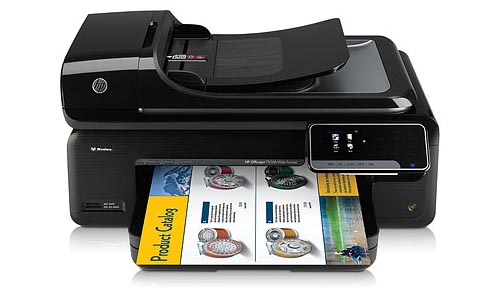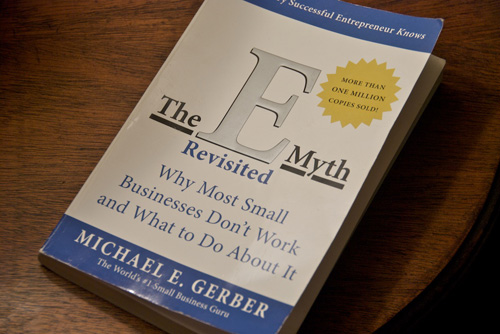Design As a Franchise-able Commodity? or, Is a Logo Worth More Than an Inkjet Printer?
Filed under: "Whitestone Design Werks", Design, Logo Design
I recently had a book recommended to me by a friend that has evidently been must-reading for entrepreneurs for years called, The E-Myth Revisited, by Michael E. Gerber. I was aware of the book, but it had never been on my reading list. After my friend flat-out told me that, “You have to read this book” while simultaneously thrusting his well-worn copy into my hands I decided to take him up on his exhortation. While it has more of a Zen influence then I would like, I still found myself quite captivated with all of the business possibilities it stirred up in my mind (and heart). While there were many insightful sections that have stirred me to re-evaluate my own business model, I found myself in a bit of a frustrating quandary. For those who haven’t read the book, I won’t spoil too much (other than they all die in the end) by revealing that much of the business model is based upon developing a franchise-able vision for your company. My quandary was that I could not reconcile my appreciation for the franchise model which relies on developing systems that deliver quantifiable and repeatable, consistent results, with the reality of my business which at its very essence relies on uniqueness, abstract thought, subjective opinion and thinking “outside the box” as it were. How could a design business be modeled as a business that could be franchised?
Having worked at Wendy’s during my late high school and early college years (advancing to assistant manager shortly after graduating H.S.!), I learned many of the advantages of a well-run franchise system. My daughters cringe whenever I tell one of my now oft-repeated Wendy’s stories when cooking or cleaning the kitchen or reorganizing storage shelves in the garage. Later in my career, I worked in the in-house marketing department of Red Lion Hotels (hey, did you know I designed that logo?) and was able to see a large-scale franchise system in a whole new light. So, I have a deep appreciation for the franchise model and most everything that I was reading rang true with my own experience with the exception of the most important experience of all—my own company. The book had me enthusiastically exploring many exciting possibilities in my mind of potential businesses that would fall into this model perfectly, but when it came to applying this mindset to Whitestone Design Werks, I found myself deflated as I realized the difficulty in quantifying something as subjective as the design creation process. While its true that many of the areas that are common to all businesses such as basic bookkeeping, marketing and business development also apply to any design business, but the core, essential element of any successful design firm has got to be its ability to create unique solutions based upon a wide-range of varying parameters for each client. My mind just short-circuited when it tried to make this square peg fit in the round hole.
I was coming to the conclusion on my own as I continued reading but Michael pretty much put the nail on the head when on p. 100 he made the point that, “The Model Will Be Operated by People with the Lowest Possible Level of Skill” referring to the process of creating a prototype system that can be replicated through standardized processes on a consistent basis (think McDonald’s). He reiterated his point by stating that “…if your model depends on highly skilled people, it’s going to be impossible to replicate.” The conclusion I came to was that while the book was definitely a great resource of inspiration for a truly entrepreneurial approach to building a vision for a business that can be developed to run as efficiently as a franchise model, not every type of business has to take this approach in order to be successful. One thing to note about the book is that it isn’t talking about creating a franchise system for every business, but that the process of creating a system that can be franchised, is the same process that should be applied to make a business successful—whether it is ever franchised or not .
The positives that I could still take away were the facts that I am a “technician” by nature that was overcome by an “entrepreneurial fit” when I started this business and that I needed to remove myself from the technician role and rethink through the business from a more truly entrepreneurial mindset that looks at the whole of the business and not just the commodity or service that it sells. There were many other take-aways from the book that I will be working through as well (and for that, I would heartily recommend reading the book for any business owner or anyone who is thinking about starting a business), but back to the main point of this article was the fact that I was working through the question about whether a design business or even the creative process of design could be incorporated into a franchise-able model.
That question led me back to thinking through the process of design and the value of design. Until the advent of “desktop publishing” and the idea that, with a Macintosh computer, Aldus Pagemaker, Adobe Illustrator and an Apple LaserWriter printer with Adobe PostScript (or even worse, a Windows 3.1 PC with MS Word, MS Publisher and CorelDraw!), “anybody” could now design a brochure or newsletter. It took between 10 and 15 years for most businesses to finally realize that you still needed to have someone with some level of true design talent and more than the “lowest possible level of skill” to operate one of these magical machines.
So, to get back to the question of whether or not the business of design could be molded into a franchise-able model; until recently, I would have confidently said no. Even with the advent of the computer, design had still not been reduced to a commoditized service—until now. Now, I would have to say a reluctant yes. But just because it is possible, doesn’t mean it’s a good thing.
With the advent of internet-based crowd-sourcing design sites (I’m intentionally not naming or linking) and the proliferation of “Affordable Logo Design” sites, these have worked together to erode the perceived value of design (logo design in particular) down to the same price range as a disposable inkjet printer. At first blush, the reasoning seems sound; every business needs a printer as well as every business needs a logo. Why should I have to pay more for a logo than I do for a printer? Seems like a reasonable request for a budget-conscious business just boot-strapping itself up and looking to save costs wherever and however it can. You’d be a fool to not consider only paying $250 for a logo as opposed to $2,500 (or more) when you’re basically getting the same thing. Or are you?

Why is this not a good thing? At face-value, it seems like a no-brainer for any small-business owner. I have to admit, the designs being produced by these sites are occasionally not that bad and sometimes surprisingly well-done—to the consternation of many designers trying to convince potential clients that their higher costs are justifiable to an increasingly web-savvy clientele. To add insult to injury, any business that does even a half-hearted Google search for “logo design” is going to come across the alluring temptation of one of these sites long before they ever find a good local designer or design firm’s site. Unless that designer/design firm has established a word-of-mouth referral reputation and/or coupled it with an effective self-promotion strategy, there is a shrinking pool of small to medium-sized businesses that are looking for their services or even care. Designers that don’t have a client roster of companies that understand the need for good design and are familiar with the process and costs normally associated with producing that level of design have had to rely on trying to attract smaller business start-ups that are seemingly clueless about the value of their identity in establishing their brand in their target market. To them, when faced with a simple cost-to-savings question, will choose the lower cost almost every time. It is increasingly rare to find a new business start-up that truly understands the importance of their identity and has made the decision to allocate a priority place in their budget to invest in the creation of their brand-building image—which is much more than just a logo.
In a future post, I’ll explore some of the issues involving the speculative and exploitive nature of crowd-sourcing design and how it is neither the best solution for the business nor the designers who take part in the process. I will also take a look at how a business should realistically look at the value a good designer or design agency can bring to their business identity and the value it adds to implementing an effective branding strategy.
In the meantime, if you’re looking at investing in the identity of your business either as a start-up or as a business that has recently realized the importance of re-establishing the position of your identity to reflect its maturing vision and capabilities, I challenge you to consider the value of that identity and hopefully you’ll come to the conclusion that it is worth far more than a plastic HP inkjet printer that will end up being a money pit of ink cartridges and paper and a jammed paper path that to repair would be more expensive than just buying another cheap, plastic HP printer. Hey, maybe I should start an inkjet cartridge-filling franchise! At least I know a cheap place to get a logo.




[…] This post was mentioned on Twitter by Russell Heistuman, CDA_Rob. CDA_Rob said: RT @rheistuman: Design As a Franchise-able Commodity? or, Is a Logo Worth More Than an Inkjet Printer? http://bit.ly/9VHy0w New blog post […]